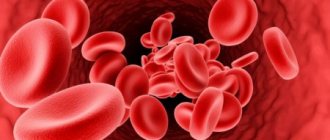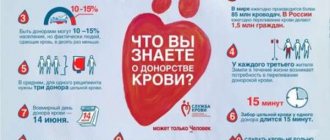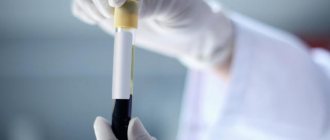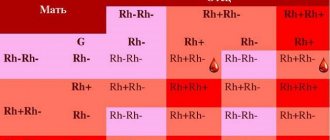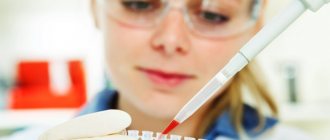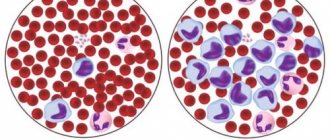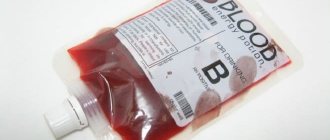In medical practice, there are cases when a patient experiences severe and profuse blood loss. In this case, there is a need for transfusion (transfusion) from another person. Before the procedure, many tests are carried out to determine the possibility of matching the group and Rh factor. Transfusion of incompatible blood in complicated cases can be fatal. It is generally accepted that those with the first blood group are universal donors. Many modern doctors argue that this compatibility is conditional and there is no blood suitable for everyone.
Which blood group is 4 positive?
Scientists suggest that at first people had only blood group I.
During the evolution of humanity, mutations occurred at the gene level. The changes also affected the blood. The fourth group appeared later than others in the process of mixing genetics. In this case, the Rh factor can be either positive or negative. Approximately 15% of the population in Europe has Rh negative blood. People with blood group IV are Rh positive in most cases. Blood cells of blood group IV contain two antigens (A and B).
Blood transfusion is not a simple medical procedure
It is important to consider several different factors. Before donating blood, the doctor conducts a survey, studies clinical data, and performs the necessary tests.
It is necessary to find out whether the blood groups are compatible. Otherwise, red blood cells may stick together.
The blood pressure of the donor and recipient is measured and possible contraindications are identified.
- Determine blood type.
- Find out the characteristics of red blood cells in the donor and the patient.
- Determine overall compatibility.
- Conduct a bioassay.
Pure blood is usually not used for transfusion. You can transfuse red blood cells or blood products. In special cases, when the patient's life depends on the transfusion, direct transfusion from the donor is performed. However, during transfusion, not only the blood type is important, but also the Rh factor.
It can be difficult to find a donor with blood type IV and Rh negative. Blood of any group can be used for transfusion, but also with negative Rh. In any case, a test is carried out for individual compatibility.
Blood transfusion is a complex process. Even after a complete compatibility check, the blood may not take root. The patient may experience negative consequences for the body. Therefore, the procedure is carried out if they know that they cannot do without it. Fortunately, such problems are rare these days.
The compatibility of the parents' blood groups is of great importance not only during blood transfusions, but also when planning the birth of a child. When a woman with a positive Rh factor and IV blood group has hemorrhage during labor, suitable blood may not always be available. There may be difficulties with donors.
When pregnant, if the father has a negative Rh, it may happen that the mother’s body begins to produce antibodies to the fetus. This is a Rhesus conflict. If the pregnancy is the first, then antibodies accumulate towards the end of the term. In subsequent pregnancies, deviations in the development of the child are possible, and there is a danger for the mother. Pregnancy can be terminated in the early stages.
When conceiving a child, you need to know that the I positive group of the father is compatible with any group of the mother. Group III in men is compatible only with III and IV in women. With this combination, complications are rare.
For a man with group IV, a woman of the same blood type is suitable for conceiving a child. Otherwise, there is a risk of pathologies in future children: autism, delayed mental and physical development, etc.
If the qualities of red blood cells are incompatible, mutual attacks are inevitable. For prevention, a woman is examined at 27-30 weeks. If necessary, a course of immunoglobulin is prescribed. In especially severe cases, a blood transfusion is given to normalize the red blood cells of the unborn child.
Thus, it is important for every person to know what their blood type is. Knowledge about the possibilities of blood transfusion will also be useful.
Owners of the rare IV group should remember its features so that there are no health complications when planning children and blood transfusions.
Compatibility
Almost 50% of the entire population has the first group, the second is limited to approximately 30%, the third barely reaches 15%, and the fourth - no more than 5%. Blood is characterized by positive or negative Rh, so it must be taken into account when transfusing. This is very important because in Rh positive the antigen is located on top of the red blood cells. It is extremely rare to meet people with negative Rhesus, where the antigen is absent.
Blood group compatibility
Reference! Women who are Rh negative may face pregnancy problems in the future. It is possible that conception will have complications if the child inherits Rh positive from the father.
When transfusing, specialists use two concepts: the recipient, the one who accepts the biological material, and the donor, who gives the blood. Based on this:
- Group 1 is suitable only for Group 1;
- The 2nd group is suitable for both the 1st and 2nd;
- 3rd group will suit 1st and 3rd;
- Group 4 is suitable for all groups.
Blood group compatibility table
It is important! Depending on who will be the recipient and who will be the donor, compatibility will be determined. For example, group 4 (as a recipient) is compatible with all other groups.
Description of the first blood group
Which blood type is suitable for everyone?
The very first successful blood transfusion was recorded in the mid-17th century in France. Then the man's life was saved thanks to the lamb. But at that time, doctors had no idea about such a concept as blood type and, of course, they could not know which blood type suits everyone, so it is safe to say that the young man was simply lucky.
Only at the beginning of the 20th century, after numerous studies, the Austrian biophysicist Karl Landsteiner determined the principle of dividing human blood into 4 types, and also introduced the concept of “incompatibility”. Humanity owes millions of saved lives to him.
So, there are 4 main groups, they are usually designated as follows:
0 (I) - first (zero) A (II) - second B (III) - third AB (IV) - fourth
Thus, people with group II (A) have antigen A, carriers III (B) have B, IV (AB) have both antigens, and those belonging to group I (0) do not have them at all. The opposite situation is observed in blood serum: it contains so-called agglutinins to “foreign” antigens (α and β).
Gluing of blood cells will not occur in the absence of the same antigens and agglutinins. But when a “foreign” element enters, agglutinins immediately attack it and provoke the gluing of foreign red blood cells. The result can be fatal - oxygen stops flowing, small vessels become clogged, and after some time the blood begins to clot.
About 40-50% of people are carriers of the first group. Owners of the second – 30-40%. The third - 10-20%, the least number of people with the fourth - only 5%.
To avoid the danger of coagulation, Landsteiner proposed transfusing recipients with the first group with the same donor blood. Thus, the first group, due to the lack of antigens, is universal, and its owners are considered universal donors.
People with group IV are called universal recipients: they are allowed to receive any blood. Those with group II or III can receive a similar transfusion, as well as the first
It is important to remember about the Rh factor. People can only be given blood that matches their Rh factor.
Blood rhesus is an antigen that is found on the surface of red blood cells. It was also discovered by Karl Landsteiner and his colleague A. Weiner. About 85% of Europeans are Rh positive. The remaining 15% (7% in Africans) are Rh negative.
It is also worth noting that today scientists distinguish more than 250 types of blood, which are combined into 25 systems. Therefore, the issue of compatibility continues to be the subject of research, and will be reviewed more than once.
- Privacy Policy
- Terms of use
- Copyright holders
- Adenoma
- Uncategorized
- Gynecology
- Thrush
- About blood
- Psoriasis
- Cellulite
- Ovaries
Universal blood for transfusion: myth or reality
Blood type is a parameter that divides people into different types. This is a special criterion that is given to us from birth. People's blood type does not change throughout their lives. But individual blood can be changed in the laboratory. This is what various scientists have been doing for decades.
The love for comparative analysis pushes scientific specialists to find out how and how different blood groups are from each other. Can all types of blood be transfused to different people or is there some kind of universal blood for transfusion?
- How is blood distributed among groups?
- Experiments in creating universal blood for transfusion
- Are blood type and human health related?
How is blood distributed among groups?
Blood consists of different cells , the basis of which is erythrocytes. These are blood cells; their membrane contains proteins and protein-carbohydrate complexes. In the AB0 system, two complexes are separated - A and B. It is their presence that determines the blood group.
The basic blood distribution system was discovered back in 1900 by Landsteiner and deservedly received the Nobel Prize 30 years later. According to this system, all blood is divided into 4 types 0, A, B, AB , also called I, II, III, IV.
How do these groups differ:
• 0 or I – this blood group is distinguished by the absence of agglutinogens A, B;
• A or II – blood cells contain only the A complex;
• B or III – erythrocytes have proteins B;
• AB or IV – owners of both complexes.
Not all blood is suitable for all people. When transfusing, it is very important to take into account that group A blood contains antibodies to antigen B, and group B blood, in turn, contains antibodies to antigen A.
Blood plasma of group 0 (I) contains both antibodies, while blood of group AB does not have any antibodies.
Transfusion of blood with incompatible antigens may cause adverse effects.
Studying blood compatibility is very important when planning transfusion. Incompatible blood types are one of the most common causes of serious and sometimes fatal events.
Based on this, it was found that group 0 (I) red blood cells, which lack A and B antigens, are the only blood group that is available to everyone for transfusion. Therefore, group 0 is considered universal blood .
There are cases when a person has several blood groups in his body. This happens in patients with a bone marrow transplant. This phenomenon in nature is called chimerism.
Experiments in creating universal blood for transfusion
Having realized that universal blood is 0(I), scientists began to actively conduct research into its creation by piece.
The essence of the blood change is the processing of red blood cell complexes with special enzymes. These enzymes erase immunodominant sugar residues and convert them into group 0 red blood cells.
The Chinese were among the first to try to make unique blood based on the protein albumin.
Romanian scientists created universal blood
Scientists from Britain took stem cells as the basis for their development. Their plans are to create universal blood with a negative Rh factor suitable for 98% of people.
Subscribe to our INSTAGRAM account!
In 2007, scientists from Copenhagen created enzymes from the bacterium Bacteroides fragilis, which removes the B antigen, and the bacterium Elizabethkingia meningosepticum, which removes the A antigen from the blood. Thus, universal blood type 0 is obtained.
The latest development was made by scientists from the University of British Columbia in the USA. Stephen Withers and his colleagues, through research, extracted 20,000 different DNA samples from intestinal bacteria.
He was able to discover that some bacteria can produce enzymes that transform blood. This is how the biochemist managed to convert any type of blood into universal 0-negative blood.
Newly developed blood may not be universal for absolutely every person. Its practical application is still being studied in detail and will take time, but what is certain is that it will help save millions of human lives.
Are blood type and human health related?
A lot of research was carried out, and it was found that, in fact, in a small percentage, blood type influences various predispositions and the development of diseases in humans.
What is certain is that:
• People with blood type I are less likely to suffer from diseases of the cardiovascular system, but suffer more from gastrointestinal diseases, especially ulcers.
• People with blood group II are more likely to experience thrombosis compared to other groups.
• Group III has a low percentage of Parkinson's disease.
• Carriers of blood group I are also distinguished by strong immunity.
• And carriers of group II are better disposed towards sports and physical activity.
This confirms that blood type influences a person’s life, but obviously does not determine it 100%.
However, the hypothesis about nutrition based on blood type is absolutely not confirmed and only remains an assumption.
Universal blood is not a myth, but a reality - this is group I. It is suitable for transfusion for everyone, since it does not contain A and B antigens.
The invention artificial blood
The blood is cleared of antigens using enzymes. A lot of research is being conducted on this issue, but all of them require further development and testing.
We hope that in the near future, universal blood will become available for any transfusions and will help in operations. estet-portal.com
If you have any questions, ask them here
PS And remember, just by changing your consciousness, we are changing the world together! © econet
Rh factor value
This concept was first discovered in 1940 by scientists K. Landsteiner and A. Wiener, and now it is difficult to overestimate its importance.
The Rh factor does not change during life, but it can be inherited
It refers to proteins that are contained in red blood cells, are inherited and do not change throughout life.
Today, 85% of the world's population are carriers of a positive Rh factor and only 15% are carriers of a negative one.
Its meaning is as follows:
- When transfusing blood with different Rhesus, there is a high probability of death. For example, a 3 negative blood group will only be compatible with a 3 negative or 1 negative;
- A difference in Rhesus can lead to the death of a child in the womb if he is Rh positive and the mother is Rh negative.
The latter is due to the fact that a woman’s body perceives a child with a different Rh factor from hers as a foreign body or infection. As a result, the woman’s body actively fights against the object that disturbs it, which leads to miscarriage or placental abruption. This happens especially often in cases where a woman has a high level of immune defense.
Rhesus conflict between mother and fetus can lead to its death
A little about the main thing
The blood group test that determines is very important for a person. It allows you to be prepared for different life situations: donation, development of genetic pathology, bearing a child. Blood compatibility is of great importance for conception. If the husband and wife do not have it, the pregnancy process is accompanied by serious difficulties.
The emergence of different types of people is due to the expansion of human habitation and changes in diet. The daily menu began to include meat and dairy products. This affected the qualitative composition of the biological fluid.
The classification of human blood groups is represented by the AB0 system. It is based on two indicators:
- the presence in erythrocytes of special substances of a protein nature - antigens A and B;
- the presence of antibodies in the plasma - agglutinins α and β.
According to the AB0 system, there are four types:
| Types | Description |
| 1 group | Absence of antigens and presence of antibodies α, β. |
| 2 blood group | Presence of anti-A in erythrocytes and β antibodies in plasma. |
| 3 blood group | The content of anti-B in the erythrocyte membrane, and α antibodies in the plasma. |
| Fourth group | There are A and B antigens on the surface of red cells; there are no α and β antibodies in the blood. |
The question of which blood groups are compatible and which are not should be of interest even before a problematic situation arises. The test can be done in any laboratory quite quickly. Knowing your blood type, its compatibility with others, and a timely examination for this will significantly save precious time if necessary.
Compatibility check
Blood transfusions were carried out several centuries ago. Some experiments brought the expected results, others ended unsuccessfully. They couldn’t explain it then, but at the beginning of the 20th century. learned about the differences in the composition of biological fluids. It turned out that not every blood is suitable for another person. The universal blood group is considered to be first negative. If there is no compatibility, transfusion can be fatal.
The differences are based on the presence of different types of antigens that are found in blood cells - red blood cells. On their surface there may be antigens of type A, B or absent. If donor material enters the body, which contains antigens that the patient does not have, the red blood cells stick together and the blood clots.
Before proceeding with the transfusion, it is necessary to ensure that the blood is suitable for the patient. To do this, tests are carried out during which biological fluids are mixed and the presence of the process of red blood cell adhesion is assessed. To reduce the likelihood of complications to a minimum, a small amount of donor fluid, 10-15 ml, is infused into the recipient and his condition is monitored. If undesirable reactions such as fever, shortness of breath, tachycardia are detected, the transfusion procedure is not performed.
Important information: How to determine the gender of the unborn child based on the blood type of the parents and calculate from the table who will be a boy or a girl
Heredity
When a new life is born, it depends only on the parents what blood type the baby will receive. An important role is played by the compatibility of parents during conception and pregnancy. The fact is that the genes of the mother and father are equally involved in the creation of a new person. The blood type in itself does not matter, and when different groups are combined, the child will receive either the blood of the mother or the father, or, through the process of mutation, a different type. But with different Rh factors, an immune reaction occurs. If the child has the antigen, but the mother does not, a Rh conflict occurs. Agglutinins are produced and proteins are destroyed. When positive and negative red blood cells meet again, a reaction of gluing and destruction of hematopoietic cells occurs. For the first pregnancy there is practically no danger, but during the second the mother’s blood contains such an amount of antibodies that it leads to hemolytic disease. To avoid unwanted reactions, therapy with anti-Rhesus globulin is carried out.
Risks of transfusion of incompatible groups
The main risk of blood transfusion is agglutination.
Agglutination is the process of gluing red blood cells, which leads to their destruction, and develops when blood with an agglutinogen enters the body, to which the recipient’s blood has produced agglutinin. This means that agglutination occurs when blood combines with the same antigens and agglutinins A and a, B and b. With this combination, antibodies (a or b) produced for the missing antigen (A or B) destroy donor red blood cells, resulting in their sedimentation and subsequent hemolysis (decay).
The ABO and Rhesus system is the main one for classification, but not the only one. On the surface of the red blood cell membrane there are many other antigens that are currently involved in the selection of compatible donor blood. But, more and more private clinics additionally determine the presence or absence of the rare Kell antigen, whose positive value makes donor red blood cells incompatible with any others.
Determination methods
To determine a patient’s blood type, special tests are carried out after taking a small amount of it by pricking a finger with a scarifier. There are several analysis options.
Tsoliclones
This is a simple method based on the designation of the Rh factor and components through monoclonal antibodies. There are three types:
- A;
- IN;
- D.
A drop of 0.1 ml is applied to a special tablet to which acti-A and anti-B cyclones are added. If the reaction was obtained with the first, then it is group II, with the second - III. If with neither, then I, and with both – IV. The Rh factor is determined by coliclone D, if there was a reaction with it, then (+), if not, then (-).
Cross method
It is based on the detection of the presence or absence of antigens A and B in plasma using isohemaglitinating sera and antigel α and β in erythrocytes.
For the procedure you need:
- white plates marked by numbers;
- serums;
- glass rods;
- NaCl 0.9%.
By alternately mixing drops of the material with different serums and sodium solution, the following colors are obtained:
- colorless – I;
- blue – II;
- red – III;
- yellow – IV.
Both methods give an accurate result; there are also special tests for self-determination on sale.
Factors influencing transfusion
When transfusion occurs, it is necessary to take into account the blood group of the recipient and donor, as well as their Rh factor.
Even if the type is the same, then different Rh factors are a contraindication to the procedure:
- I can only accept the same group.
- II can accept both its own and I.
- III fits I and III.
- IV accepts all other types.
Which group is right for everyone? This plate shows that the universal group is the first. It is this that can be transfused to a carrier of any other blood. However, for those who have the first type, only a person with the same group can act as a donor.
Despite its versatility, before infusing biomaterial, it is necessary to take into account the Rh factor. In case of incompatibility, a strong release of antibodies may occur, which will lead to blood clotting, which means the death of a living organism.
So, the first group can be transfused to everyone. It is considered the most common, so its supplies are usually found in sufficient quantities in medical institutions.
What is the universal donor group?
Therefore, scientists asked the question: is it possible to select a universal group that could be infused into all patients who need it.
The universal blood group is the first. This is based on the fact that when interacting with other groups, flocs were formed in some cases, but not in others. The flakes were formed as a result of red blood cells gluing together. This process, called agglutination, resulted in death.
We will talk about the universal donor below.
History of the 4th group
The opinions of scientists regarding the relatively recent appearance (no earlier than the 11th century AD) of the 4th Civil Code are divided. But there are three main theories:
Mutation of the 2nd and 3rd groups into the 4th as a result of the mixing of races: Indo-European and Mongoloid, which were characterized by individual characteristics that appeared during a long evolutionary process. This mixing began recently, which explains the youth of the fourth group.
- Another version: the emergence of the 4th group is associated with humanity’s opposition to viruses that threatened the complete destruction of the earth’s population. The response to such attacks was the development of appropriate antibodies that combine A and B.
- According to the third theory, the young fourth group was formed as a defense for the body during the evolution of the culture of eating. As food processing methods became more complex, the need arose to combine antigens A and B, which should protect the body from unnatural food preferences.
Disagreements regarding the truth of the theory of the origin of the 4th group still exist in the scientific community. But there is unity regarding the rarity of this blood.
Interesting! Carriers of different HAs have characteristic agglomerations. The first and second groups are characteristic of the inhabitants of Africa and Europe, and the third - of Asia and Siberia. The 4th GC is characteristic of the inhabitants of Southeast Asia, Japan and Australia. Traces of AB (IV) were found on the Shroud of Turin.
Most common blood type
The most common first blood group
This group is the oldest, which appeared a long time ago. Those with the first blood group usually have a predisposition to allergies, arthritis, decreased thyroid function, and also a tendency to blood clotting disorders. In addition, such people often suffer from stomach ulcers and other diseases directly related to the gastrointestinal tract.
The rarest blood type is fourth negative. The fourth positive is much more common. The fourth group is generally a mystery, because it appeared as a result of the merger of two completely different types - A and B.
This is a young group, and people who have it have a flexible immune system. This group is unique in that it appeared not due to the influence of the external environment, but as a result of mixed marriages. It is worth saying that this group is the most biologically complex.
Antigens sometimes make it similar to the second, and sometimes even to the third. Sometimes it also happens that this rare group is something of a combination of both of these groups.
It is believed that the fourth blood group appeared later than all the others - about a thousand years ago as a result of the mixing of Mongoloids and Indo-Europeans. There is also another version of the so-called “bohemian” blood group, which says that after a person was able to simply provide shelter and food for himself, he was “drawn to the beautiful” and he had a desire to express himself in creativity.
Indeed, representatives of the fourth blood group are considered the most creative individuals. The lives of such people are dominated by fantasies, emotions, love of beauty and intuition. They have a rich mental organization, a subtle perception of reality and impeccable taste.
The positive qualities of such people are kindness, compassion, selflessness and altruism. Such a person will always listen, reassure and sympathize. But at the same time, the sensitivity of such people can be considered their disadvantage.
Due to the fact that those with the fourth blood group take everything too seriously, they sometimes get carried away. These people often go to extremes. They, as a rule, act under the influence of feelings that are so intense that the mind is simply unable to curb them.
By the way, there are many fanatics among such people. But even if it doesn’t come to the point of fanaticism, the owners of the fourth group most often look like people slightly “not of this world.” They are impractical, absent-minded, often completely unsuited to solving everyday problems, and they are also very touchy about all this.
The craving for beauty in those with the fourth blood group can also manifest itself in different ways: from the creation of works of art in the most developed representatives, to psychological dependence on romance, sex and pleasure in the more primitive ones, which sometimes leads them to a vicious lifestyle.
In general, despite many advantages, owners of the fourth blood group would still benefit from some qualities that are characteristic of people with the first blood group - discipline and fortitude, for example. But even if the named character traits were not inherited by a person from birth, he may well develop them throughout his life, because habit, as they say, is a second character.
- Privacy Policy
- Terms of use
- Copyright holders
- Adenoma
- Uncategorized
- Gynecology
- Thrush
- About blood
- Psoriasis
- Cellulite
- Ovaries
Conception and compatibility
One of the areas of modern obstetrics is family planning. A thorough examination of both spouses and preparation for the birth of children had a beneficial effect on reducing the birth rate of sick children and reducing the number of infant deaths. Therefore, both women and men should know what the Rh factor is and how it can affect the process of conception, whether the compatibility of blood groups plays a role in conceiving a child, and why incompatibility is possible in the presence of one group.
In this case, it is necessary to remember the following points:
- the compatibility of a man and a woman is manifested in an immunological combination, in the absence of which the female body of the spouse produces antibodies to the components of sperm (compatibility of blood type and Rh factor does not matter here);
- a family where the husband and wife have different poles of the Rh factor can have healthy children, but subject to all the recommendations of a specialist;
- Rh incompatibility between mother and fetus affects the pregnancy process, but not the possibility of conception.
